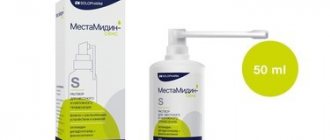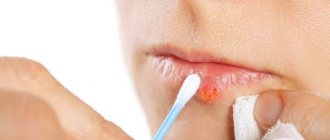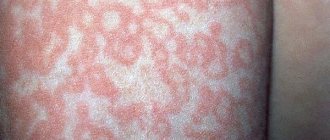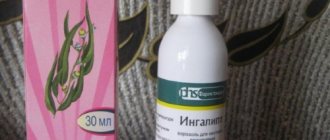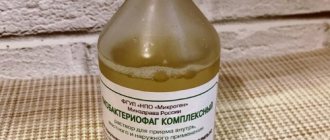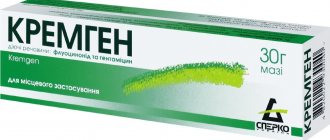Photo: stada.ru
Photo: stada.ru
Photo: stada.ru
Photo: oonkologii.ru
Povidon -Jod is an antiseptic drug. Active ingredient: Povidone-Iodine. Has a bactericidal effect.
You need to know that the presence of blood reduces the bactericidal effect of Povidone-Iodine. The drug is dispensed without a doctor's prescription!
pharmachologic effect
Pharmaceutical group: antiseptic.
Pharmaceutical action: Iodine in the form of polyvinylpyrrolidone iodine complex. The concentration of active iodine is 0.1-1%.
It has an antiseptic, disinfectant, antifungal and antiprotozoal effect. Blocks amino groups of cellular proteins. Has a wide spectrum of antimicrobial action.
Active against bacteria (including Escherichia coli, Staphylococcus aureus), fungi, viruses, protozoa.
Polyvinylpyrrolidone iodine is an iodophor that binds iodine. Upon contact with the skin and mucous membranes, iodine is gradually and evenly released, exerting a bactericidal effect on microorganisms. A thin colored layer remains at the site of application, which remains until all the iodine is released.
Pharmacodynamics and pharmacokinetics
Povidone-iodine is a broad-spectrum antimicrobial drug, as it affects most gram-positive and gram-negative bacteria. Moreover, its effect is longer when compared with inorganic iodine.
The drug in the form of suppositories is created on a water-soluble basis and does not exhibit an irritating effect during use.
Topical application practically does not cause iodine absorption from the skin, mucous membranes or wounds.
Indications
Povidone-iodine solution for external use 10%:
- Treatment and prevention of wound infections in surgery, traumatology, combustiology, dentistry;
- Treatment of bacterial, fungal and viral skin infections, prevention of superinfection in dermatological practice;
- Treatment of bedsores, trophic ulcers, diabetic foot;
- Disinfection of the skin and mucous membranes of patients in preparation for surgical interventions, invasive studies (punctures, biopsies, injections, etc.);
- Disinfection of the skin around catheters, drainages, probes;
- Disinfection of the oral cavity during dental operations;
- Disinfection of the birth canal during “minor” gynecological operations (artificial termination of pregnancy, insertion of an intrauterine device, coagulation of erosion or polyp, etc.).
Povidon Jod
Release form, composition and packaging
Solution for external use 10% in the form of a dark brown liquid with a characteristic odor of iodine. 100 ml povidone-iodine 10 g. Excipients: nonoxynol, glycerol, disodium hydrogen phosphate 12-hydrate, citric acid, sodium hydroxide, demineralized water.
Foaming solution for external use 7.5% in the form of a dark brown liquid with a characteristic odor of iodine; Foams when shaken. 100 ml povidone-iodine 7.5 g. Excipients: lauric acid diethanolamide, ammonium nonylphenylethoxylate sulfonic acid, sodium phosphate 12-hydrate, citric acid, demineralized water.
Solution for local use concentrated 8.5% 1 ml povidone-iodine 85 mg Ointment for external use 10% dark brown, homogeneous, with a characteristic odor of iodine. 100 g povidone-iodine 10 g Excipients: macrogol 4000, purified water. Vaginal suppositories 1 sup. povidone-iodine 200 mg Clinical and pharmacological group: Antiseptic for external and local use.
pharmachologic effect
Antiseptic and disinfectant drug. Released from the complex with polyvinylpyrrolidone upon contact with the skin and mucous membranes, iodine forms iodamines with bacterial cell proteins, coagulates them and causes the death of microorganisms. It has a rapid bactericidal effect on gram-positive and gram-negative bacteria (with the exception of Mycobacterium tuberculosis). It is also active against fungi, viruses, and protozoa. It has a longer action compared to a solution of inorganic iodine.
Pharmacokinetics
When applied externally, the reabsorption of iodine from the surface of the skin or mucous membrane or wounds is extremely insignificant.
Indications
Solution for external use 10%
- treatment and prevention of wound infections in surgery, traumatology, combustiology, dentistry;
- treatment of bacterial, fungal and viral skin infections, prevention of superinfection in dermatological practice;
- treatment of bedsores, trophic ulcers, diabetic foot;
- disinfection of the skin and mucous membranes of patients in preparation for surgical interventions, invasive studies (including punctures, biopsies, injections);
- disinfection of the skin around drainages, catheters, probes;
- disinfection of the oral cavity during dental operations;
- disinfection of the birth canal during minor gynecological operations (including artificial termination of pregnancy, insertion of an intrauterine device, coagulation of erosion and polyp).
Foaming solution for external use 7.5%
- disinfectant baths - for complete and partial treatment of the patient before operations;
- hygienic treatment of patients;
- hand hygiene when in contact with infected patients;
- processing of instruments (not metal) and patient care items.
Concentrated topical solution 8.5%
- for rinsing the mouth and throat.
Ointment for external use 10%
- bacterial and fungal skin infections;
- burns;
- trophic ulcers;
- bedsores;
- infectious dermatitis;
- abrasions;
- wounds.
Vaginal suppositories
- candidiasis;
- trichomoniasis;
- nonspecific vaginitis.
Dosage regimen
Solution for external use 10% For treating the skin and mucous membranes, use undiluted for lubrication, rinsing or as a wet compress. For use in drainage systems, the solution is diluted 10 to 100 times.
Foaming solution for external use 7.5% To disinfect the hands of surgical personnel, apply 5 ml of undiluted solution to pre-washed hands and distribute it evenly to the elbows, rubbing for 2.5 minutes with palms or a brush until foam forms (the foam is washed off with sterile water or removed with a sterile napkin); then the treatment is repeated.
To disinfect the skin of the surgical field, apply the drug to shaved and moistened skin with water and rub it in to form foam. 1 ml of the drug is enough to apply to the skin surface of 50-70 cm2 by rubbing for 5 minutes. The foam is removed using a sterile gauze pad soaked in water, after which the skin is lubricated with an undiluted solution and dried.
Concentrated solution for topical use 8.5% To rinse the mouth and throat, dilute 1 teaspoon of solution in 1/4 glass of water. Rinsing is carried out several times a day. Ointment for external use 10% The ointment is applied in a thin layer to the affected area 2-3 times a day, can be used under an occlusive dressing.
Vaginal suppositories
Prescribed 1-2 pieces/day. Duration of treatment is 14 days or as directed by a doctor. Before using vaginal suppositories, sanitation is necessary.
Side effect
Possible: allergic reactions. Local reactions: in some cases, allergic reactions to iodine - hyperemia, burning, itching, swelling, pain (drug discontinuation required). Systemic reactions: when used on a large area of the wound surface and mucous membranes, systemic reabsorption of iodine is possible, which can cause neutropenia, as well as change the results of tests of functional activity of the thyroid gland; with long-term use (more than 7-10 days), symptoms of iodism are possible (including a metallic taste in the mouth, increased salivation, swelling of the eyelids or larynx).
Contraindications
- hyperthyroidism;
- thyroid adenoma;
- heart failure;
- chronic renal failure;
- Dühring's dermatitis herpetiformis;
- simultaneous use of radioactive iodine;
- premature and newborn babies;
- children under 8 years of age (ointment for external use);
- pregnancy;
- lactation;
- hypersensitivity to iodine and other components of the drug.
Pregnancy and lactation
The drug is contraindicated for use during pregnancy and lactation (breastfeeding).
Use for renal impairment
Contraindicated in chronic renal failure.
special instructions
If side effects develop, discontinuation of the drug is required. The presence of blood and pus may reduce the antimicrobial effect of the drug. Do not use for bites from insects, domestic or wild animals. The patient should be warned about the need to consult a doctor if systemic reactions occur. It is necessary to ensure that no excess solution remains under the patient. A colored film is formed at the site of application, which remains until the entire amount of active iodine is released, i.e. its disappearance means the drug has ceased to act. Coloring on leather and fabrics is easily washed off with water. Do not heat before use.
Overdose
Symptoms: local irritation, allergic reactions. Treatment: reducing the frequency of use or completely stopping the use of the drug.
Drug interactions
Povidone iodine is incompatible with other disinfectants and antiseptics, especially those containing alkalis, enzymes and mercury. In an acidic environment, the activity of the drug decreases.
Storage conditions and periods
List B. Solutions should be stored in a place protected from light, tightly closed, at a temperature of 0° to 25°C. The ointment should be stored in its original packaging at a temperature between 0° and 25°C. The shelf life of the drug in the form of a solution for external use 10%, an ointment for external use 10% and vaginal suppositories is 3 years. The shelf life of a solution for external use, foaming 7.5%, and a solution for topical use, concentrated 8.5%, is 2 years.
Side effects
When used on a large wound surface and mucous membranes, systemic absorption of iodine may occur, which may affect thyroid function tests and also lead to the development of neutropenia.
In some cases, with hypersensitivity to the drug, local manifestations of allergic reactions to iodine (hyperemia, burning, itching, swelling, pain) may occur, requiring discontinuation of the drug.
Long-term use (more than 7-10 days) can cause the phenomenon of iodism (“metallic” taste in the mouth, increased salivation, swelling of the eyes or larynx, etc.), if this occurs, you should stop using the drug and consult a doctor.
Using the drug "DOCTOR IODINE"
Povidone-iodine is actively used in medical institutions: it is recommended for treating the hands of medical personnel, including surgeons, obstetricians and laboratory workers; for preparing equipment and patient skin before operations and invasive diagnostic procedures. Its use extends beyond hospitals and clinics: antiseptics are required by employees in kindergartens (kindergartens and schools), sanatorium-resort institutions, nursing homes, hospices, etc.
The drug is used to treat the elbows of donors at blood transfusion stations, and to treat the skin of patients before injections.
Household use of povidone-iodine preparations is even wider. At home, it is used for antiseptic treatment of wounds, abrasions, and cuts in adults and children. “DOCTOR IODINE” can be used as a means of preventing fungal diseases of the feet and nails after visiting public places such as swimming pools, saunas, baths, etc. This is especially true for small users who are not so attentive to personal hygiene.

